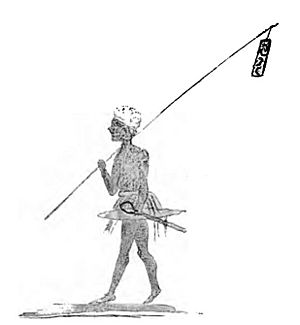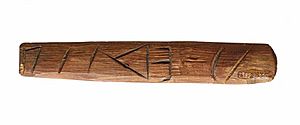Message stick facts for kids
A message stick is a graphic communication device traditionally used by Aboriginal Australians. The objects were carried by messengers over long distances and were used for reinforcing a verbal message. Although styles vary, they are generally oblong lengths of wood with motifs engraved on all sides. They have traditionally been used across continental Australia, to convey messages between Aboriginal nations, clans and language groups and even within clans. In the 1880s, they became objects of anthropological study, but there has been little research on them published since then. Message sticks are non-restricted since they were intended to be seen by others, often from a distance. They are nonetheless frequently mistaken for tjurungas.
Description and use
The message stick is usually a solid piece of wood, around 10–30 centimetres (3.9–11.8 in) in length, etched with angular lines and dots. Styles vary, but they are usually a cylindrical or slightly flattened shape.
Traditionally, message sticks were passed between different peoples, language groups and even within clans to establish information and transmit messages. They were often used to invite neighboring groups to corroborees, marriages, burials, declarations of war and ball games. Identifying marks inscribed into the stick would convey the relationship. When a messenger entered another group’s country, they would first announce their presence with smoke signals, so that they would be taken safely with the message stick to the Aboriginal elders, to whom they would speak their message.
They were sometimes referred to as talking-sticks or stick-letters, according to Robert Hamilton Mathews in 1897.
The messenger carrying the stick was granted a kind of diplomatic immunity and guaranteed safe passage into another group's territory.
Historical accounts
Anthropologist Alfred Howitt wrote of the Wurundjeri people of the Melbourne area in 1889:
The oldest man (Headman) having made such a message stick hands it to the old man nearest to him, who inspects it and, if necessary, adds further marks and gives corresponding instructions. Finally, the stick having passed from one to the other of the old men present is handed to the messenger, who has received his verbal message in connection with it. If any duration of time is connected with the message, or if an enumeration of stages or camps is made, a method is used (see Australian Aboriginal enumeration) [to explain this].
Jeannie Gunn wrote about life at a station near the site of the town of Mataranka in the Northern Territory in 1902:
Then he ['Goggle-Eye'] showed me a little bit of stick with notches on it, and said it was a blackfellow's letter-stick, or, as he called it, a "yabber-stick." It was round, not flat like most other letters, and was an invitation to a corroboree; and there were notches on it explaining what sort of corroboree it was, and saying that it was to be held at Duck Creek. There was some other news marked on it...
Donald Thomson, recounting his journey to Arnhem Land after the Caledon Bay Crisis in 1935, writes of Wonggu sending a message stick to his sons, at that time in prison, to indicate a calling of a truce. In etched angles, it showed people sitting down together, with Wonggu at the centre, keeping the peace. The sticks acquired a function as a tool of diplomacy, especially in Northern Australia.
See also
- Devil's Pool, Australia
- Koori Mail
- National Indigenous Times Australia's largest circulating Indigenous affairs newspaper
- Australian Aboriginal artefacts



